BMC Teammachine SLR 02 One Disc review
The Teammachine SLR 02 gives you performance plus comfort
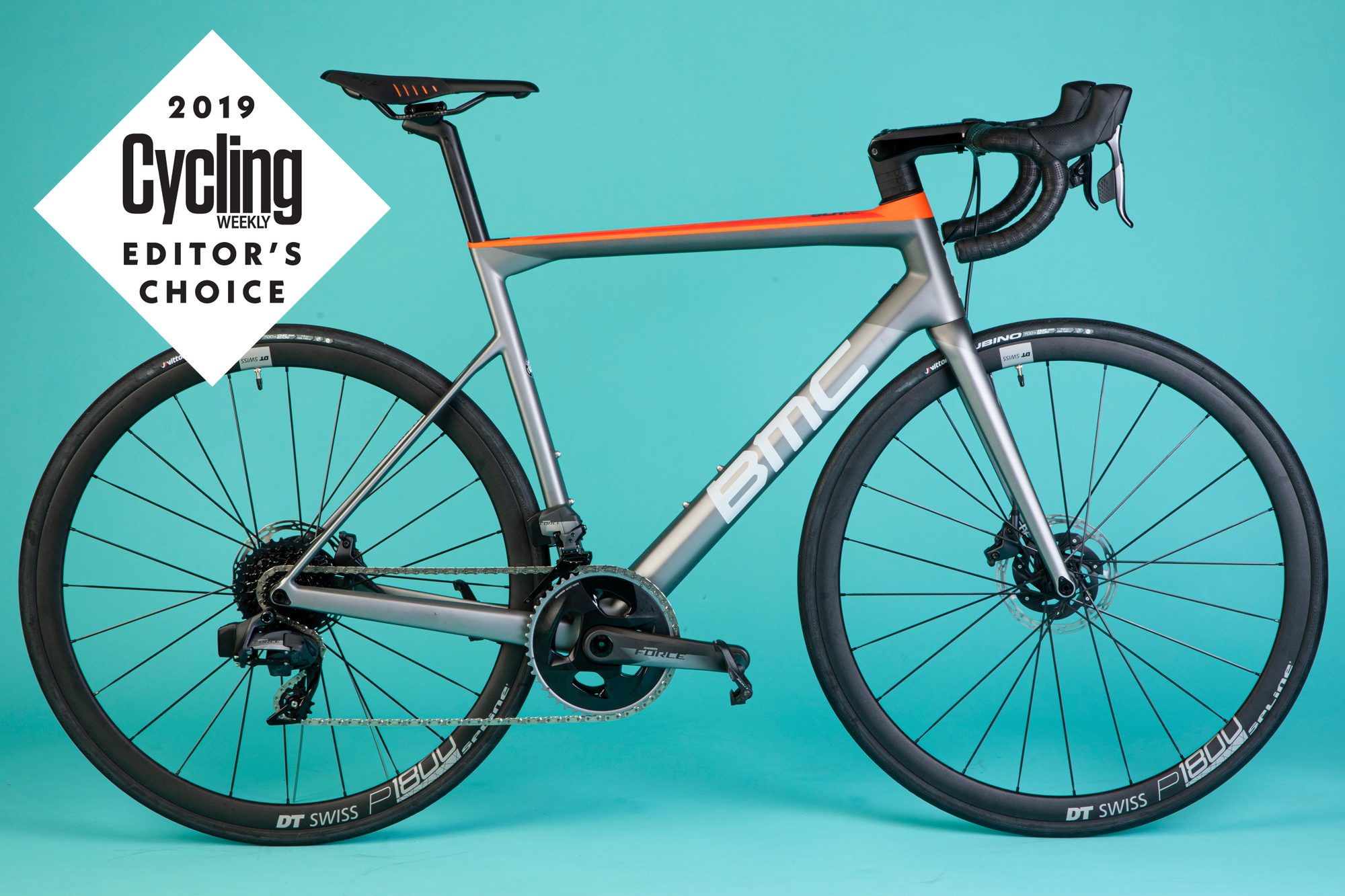
The Teammachine SLR 02 is a great bike if you’re looking for a more sporty, fast ride that doesn’t beat you up on longer excursions. It just feels fast and handling is superb. The SRAM Force eTap AXS 12-speed groupset matches the bike’s credentials well, but the supplied wheelset doesn’t live up to the rest of the spec.
-
+
Efficient, fast frameset
-
+
Comfortable ride
-
+
Excellent SRAM Force eTap AXS groupset
-
-
Wheels and tyres are a bit sub-par on a bike at this price
You can trust Cycling Weekly.

It might have a more basic frame construction than BMC’s top tier 01 level Teammachine but that doesn’t stop the Teammachine SLR 02 One Disc from bringing together a superb blend of race winning DNA and long distance comfort. Creating a richly rewarding and enjoyable ride experience, we had to include it in Editor's Choice.
BMC bikes have been a fixture of the WorldTour for years. Even if the brand is no longer headline sponsor of its own team, its bikes are currently ridden by Team Dimension Data. And the machine of choice for the pros is the Teammachine.
That depth of racing experience is reflected in the Swiss brand’s continuing relationship with Cadel Evans, who won the Tour de France for BMC in 2011. Evans still rides the Teammachine in retirement, highlighting the bike’s power transfer and handling, coupled to its compliance and comfort, which he says would leave him fresher to do battle in a race’s finale.
Frame
In common with many brands, BMC makes the Teammachine frame in two different grades of carbon, with the higher spec Teammachine 01 getting a higher modulus, lighter frameset than the Teammachine SLR 02. BMC quotes a frameset weight of 1045g for the SLR 02 Disc frameset and 375g for the fork, as against 815g for the SRL 01 frameset and 350g for its fork.
Both framesets benefit from BMC’s proprietary Accelerated Composites Evolution development tech, ACE. This used computer modelling to analyse frame designs, tube cross-sections and carbon lay-up before advancing to the production and testing of prototypes. Typically, BMC goes through tens of thousands of modelling iterations to develop a new frame.
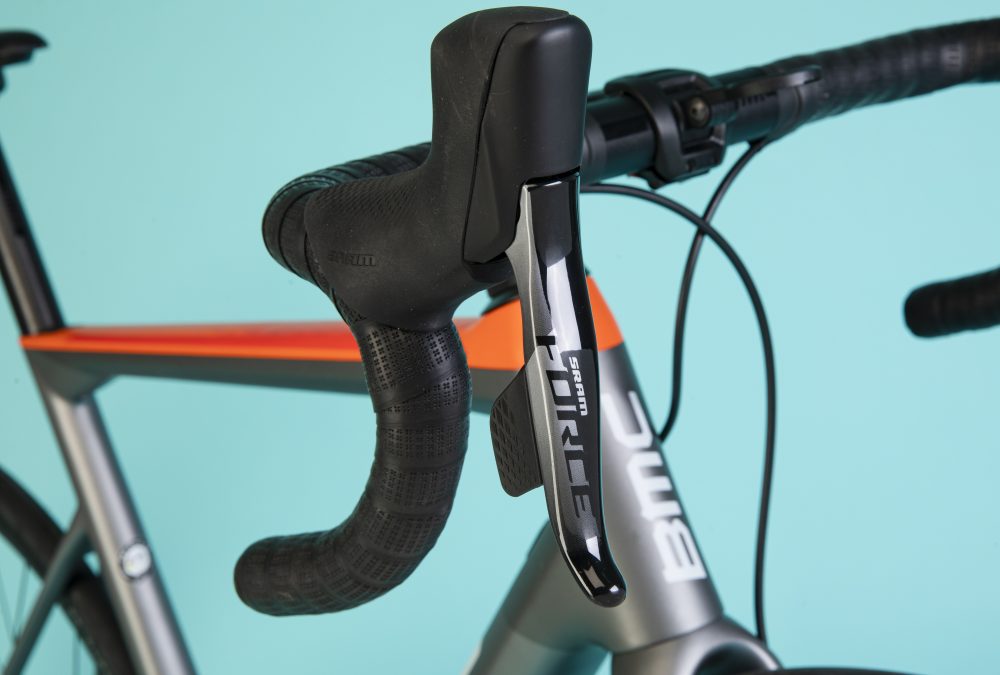
The result is a frameset with BMC’s typical clean lines, thin, dropped seatstays and characteristic angled sections at the junctions of the top tube with head tube and the seat tube. There’s marked asymmetry in the chainstays and in the fork blades, where the left side is wider than the right to handle the differential forces exerted by the brake caliper.
BMC uses its D-shaped seatpost in the Teammachine SLR 02, with the flattened rear side designed to improve compliance at the saddle, as well as saving weight over a round seatpost. BMC sells a clip-on spray guard which fits to the post, for protection when riding damp roads.
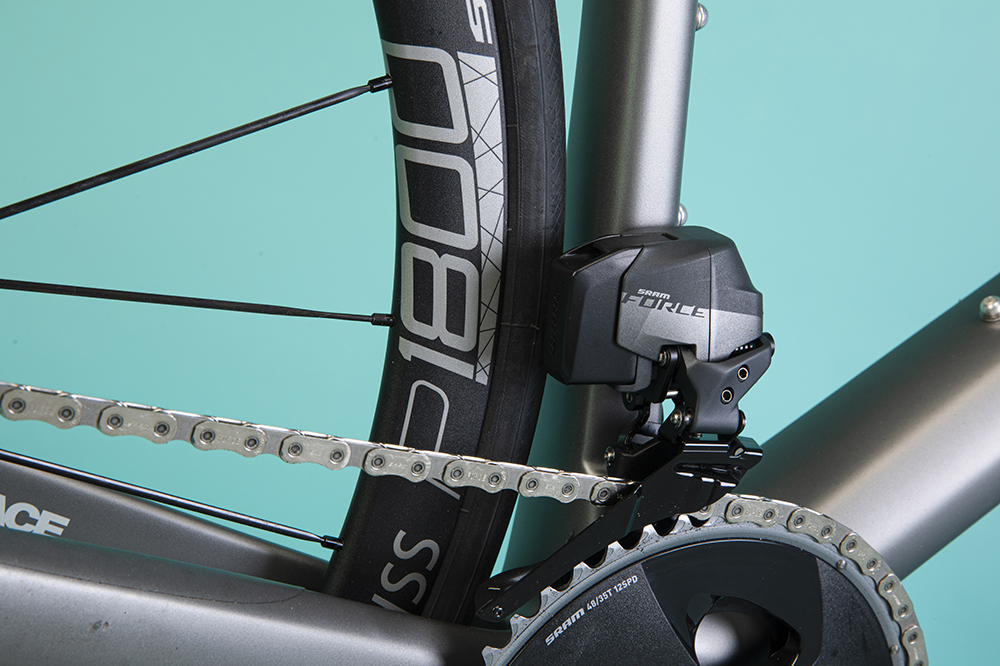
In contrast to the skinny looking top half of the bike, the Teammachine SLR 02’s down tube is massive and merges seamlessly into the PF86 bottom bracket shell. The design is not overtly aero, unlike many of the latest generation of race bikes. That’s left to the Timemachine Road range, but that doesn’t stop the Teammachine SLR 02 feeling fast, while the hefty bottom half tube sections lead to excellent power transfer.
Likewise, tyre clearance isn’t as wide as some bikes. There’s plenty of space for 25mm tyres, even on wider rims than the 18mm internal DT Swiss P1800 wheels that come with the bike. You could probably squeeze a 28mm tyre in.
Spec
BMC kits this top spec of the Teammachine SLR 02 out with SRAM Force eTap AXS. We’ve got a separate review of SRAM’s new 12-speed wireless electronic groupset here.
Suffice to say, it’s excellent. It’s not so much about having an extra gear ratio, as that SRAM has spread those ratios out over a wider range. So you have the same top end as on a 53x11, but can keep in the large ring for longer on uphills too. When you do switch to the small ring, there’s the low range to get up steeps – the same as a 34x32. The fluid clutch in the rear mech helps keep the chain under tension and avoid clatter, while rear shifting is precise and rapid.
The AXS part of the name refers to the groupset’s Bluetooth connectivity with SRAM’s phone app, which lets you configure the shifting and check battery status, amongst other functions. In standard configuration, shifting is intuitive: right paddle to shift up, left to shift down, both together to swap chainrings, but you can also use the app to automate front shifting or set Force eTap AXS to make compensatory rear shifts when you change chainrings.
The Teammachine SLR 02 One comes with BMC’s ICS integrated stem. It merges neatly into the fork’s steerer tube, with a set of aero-shaped split spacers below it, which can be removed without needing to remove the stem.
There’s internal routing for cables through the stem, although on the Teammachine SLR 02 One, this isn’t used: the brake hoses run externally into the frame and fork and there are no mech cables with the wireless groupset. You can purchase a Garmin and a GoPro mount for one of the best bike and helmets cameras that clamp under the neat stem faceplate, which wraps around the bar, concealing its clamping bolts.
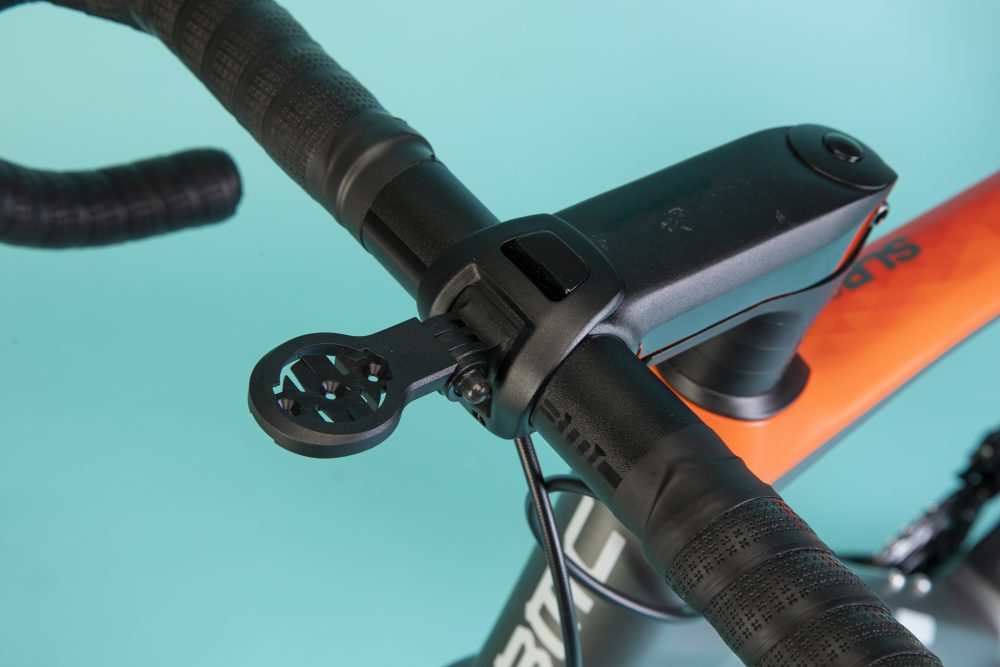
BMC fits a quality Fizik Antares saddle. It’s a bit wider than an Arione and I found it comfortable for longer excursions.
The wheels are DT Swiss P1800 Spline 32 db alloys. They’re best described as workaday, although their deeper section and aero bladed spokes add a bit of pizzazz. DT Swiss claims a wheelset weight of just over 1800g and an internal width of 18mm. They are likely to prove durable and cope with poor weather, although the Teammachine SLR would certainly benefit from something more exciting.
The fitted Vittoria Rubino 25mm tyres roll well, feel compliant and should be durable too, although they are quite heavy. Again, it would be worth an upgrade for summer use.
Riding the BMC Teammachine
You can feel the Teammachine’s race-winning DNA right away, as soon as you start to ride. With that aggressively stiff bottom bracket and chainstays, every watt of power feels as if it’s being transmitted to the road. So I was up at the top end of the cassette even on flatter roads and making extra speed on downhills.
There’s an agreeably precise feel to the handling, making fast descents confident, even on broken and wet surfaces and making it easy to pick and hold a line through hairpins and more gentle curves.

The SRAM Force eTap AXS groupset is a good match for this high tempo and I was able to use the extended range offered to push on in the large ring over undulating terrain to the east of Oxford.
I switched the groupset to sequential mode for some of my rides, where the groupset swaps between chainrings at specific points in the gear range, without you needing to initiate the change.
Shift up to the large ring is smooth. But the swap to the small ring comes on the second-to-largest sprocket and can be a bit jarring, particularly if you’re coming off a fast downhill onto a sharp ascent. Fortunately on these occasions, you can still use the levers to initiate a chainring change manually and pre-empt the system.
Despite its racing credentials, the Teammachine SLR 02 is still very comfortable for longer rides. There’s plenty of compliance in the skinny, dropped seat stays and D-shaped seatpost and the Fizik Antares saddle is well shaped and a bit broader than an out-and-out racing saddle like the Arione. Even on four hour plus rides, I didn’t come back feeling beaten up.
Value
BMC bikes tend to be a bit pricier than some brands, probably a reflection of the brand’s Swiss roots. But its pricing isn’t too out of line with comparable race-ready bikes from other high end marques with WorldTour racing credentials like Scott, Merida and Cervélo.
SRP for the SRAM Force eTap AXS groupset is over £2000, which is a fair chunk of the Teammachine SLR 02’s £5200 list price and there’s clearly been a significant investment in development of the excellent frameset. Plus BMC’s bespoke seatpost and stem add cost over off-the-shelf components.
Buy now: BMC Teammachine SLR 02 Disc One for £5199 at Tredz
There has to be some give somewhere and as tends to be the case, that’s in the wheelset. That’s a logical compromise, as most riders looking to spend north of £5000 on a bike are likely to have a set of the best road bikes wheels hanging in their shed, or the funds to purchase one.
But the need to run an XD-R cassette body for the SRAM 12-speed groupset adds complication to a wheel swap. And the supplied DT Swiss wheels are a good all-weather training option in any case, although at around £350, they’re certainly not up to the standard of the rest of the bike.

Thank you for reading 20 articles this month* Join now for unlimited access
Enjoy your first month for just £1 / $1 / €1
*Read 5 free articles per month without a subscription

Join now for unlimited access
Try first month for just £1 / $1 / €1
Get The Leadout Newsletter
The latest race content, interviews, features, reviews and expert buying guides, direct to your inbox!
Paul started writing for Cycling Weekly in 2015, covering cycling tech, new bikes and product testing. Since then, he’s reviewed hundreds of bikes and thousands of other pieces of cycling equipment for the magazine and the Cycling Weekly website.
He’s been cycling for a lot longer than that though and his travels by bike have taken him all around Europe and to California. He’s been riding gravel since before gravel bikes existed too, riding a cyclocross bike through the Chilterns and along the South Downs.
-
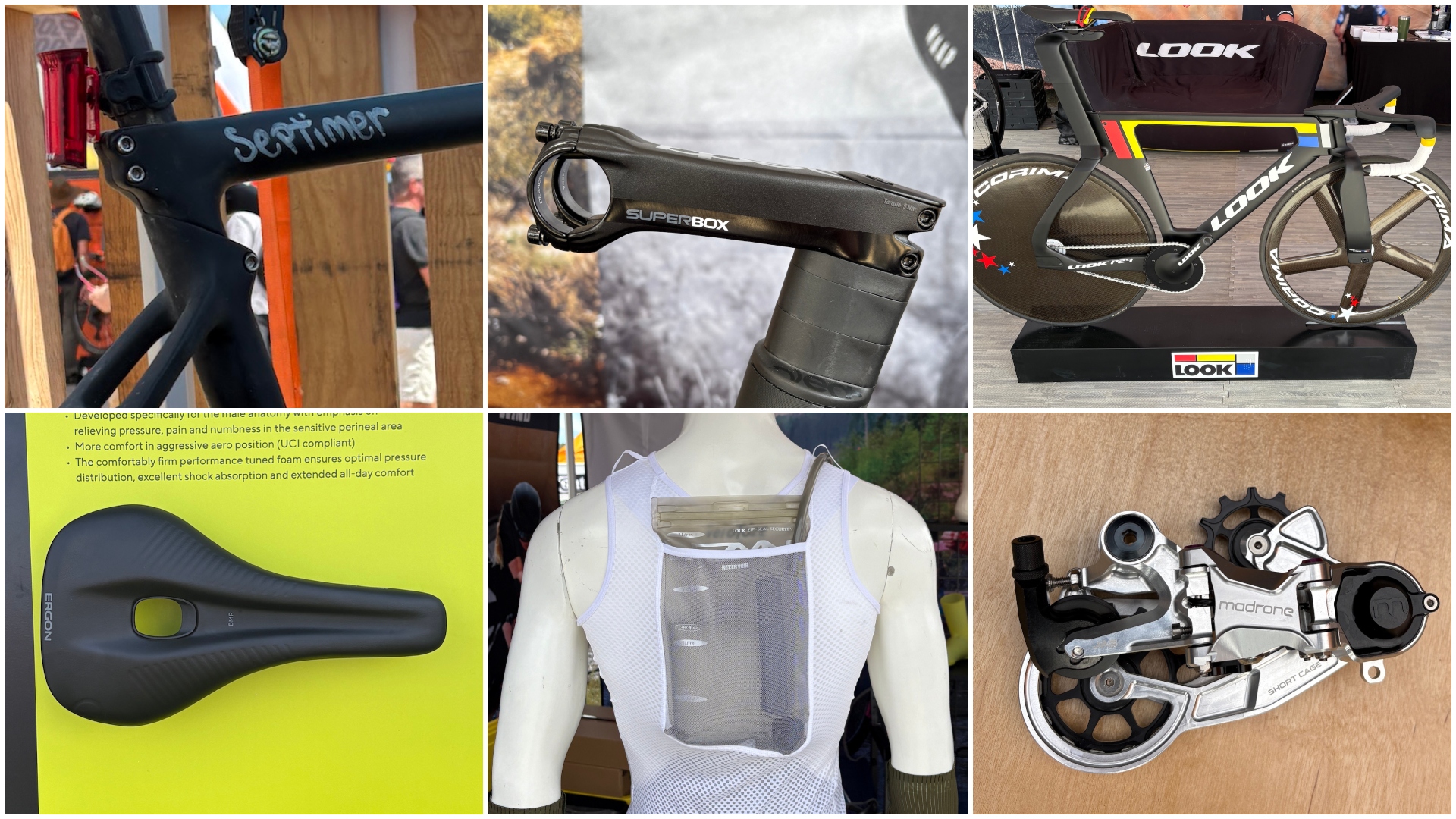 The Sea Otter Classic: sights and sounds from the biggest bike gathering in North America - Part 1
The Sea Otter Classic: sights and sounds from the biggest bike gathering in North America - Part 1Odds and ends that run the gamut, from a $13,000 frameset to armoured kit and new hydro-vests
By Tyler Boucher Published
-
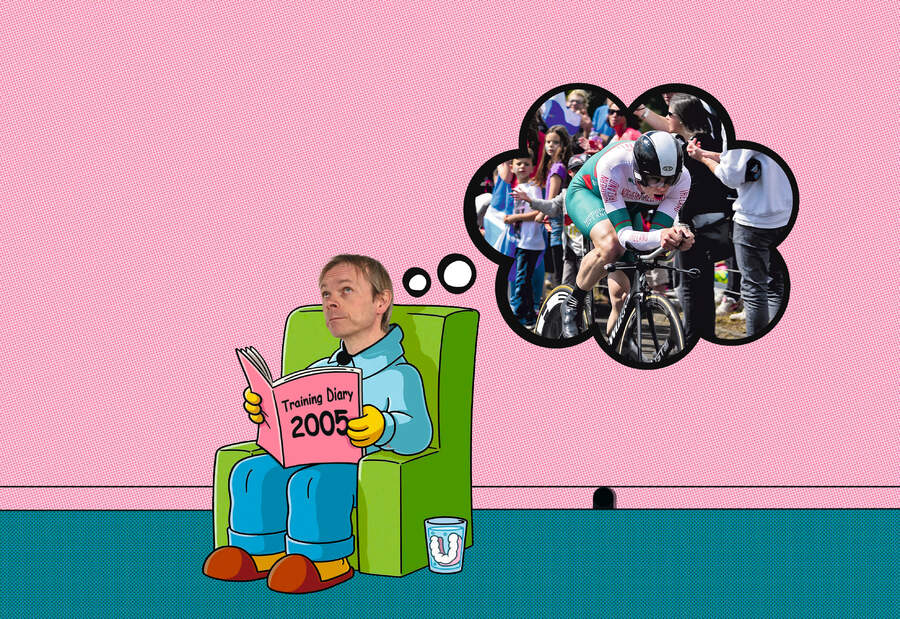 The thing that bothers me most when I look back at old school training is that right now we’re doing something equivalently misguided
The thing that bothers me most when I look back at old school training is that right now we’re doing something equivalently misguidedOur columnist's old training diaries reveal old-school levels of lunacy
By Michael Hutchinson Published
-
 'This race is absolutely disgusting': Peloton reacts to another brutal Paris-Roubaix Femmes
'This race is absolutely disgusting': Peloton reacts to another brutal Paris-Roubaix FemmesNow in its fifth edition, Paris-Roubaix Femmes is still a tough race, even for the best bike riders in the world
By Adam Becket Published